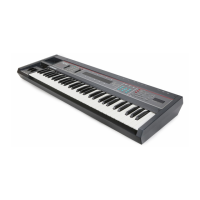SQ-80 — Musician's Manual
REAR PANEL CONNECTIONS
AUDIO OUTPUTS:
1) Right/Mono — To operate the SQ-80 in Mono, use this jack only. To operate the SQ-80 in Stereo.
connect this Output to a channel of your Mixer and pan that channel Right. If nothing is
connected to this jack, both channels of the
SQ-80's output will be sent in stereo to the Left/
Phones Output for use with headphones.
Specs: In Left&Right mode: 680 Ohm output impedance. DC coupled. In Mono (summed) mode: 340 Ohm output impedance. DC
coupled. Line level output into 10 KOhms or higher (one voice=1 Vp-p typical; all voices= 15 Vp-p)
2) Left/Phones —When operating the SQ-80 in Stereo, connect this Output to a channel of your
Mixer and pan that channel Left. To listen to the
SQ-80 in stereo through headphones, plug the
phones into this jack (make sure nothing is plugged into the
Right/Mono jack, or the headphone
output will not work properly). When nothing is connected to this jack, both channels of the
SQ-
80's output will be summed together and sent in mono to the Right/Mono Output.
Specs: In Left&Right mode: 51 Ohm output impedance. DC coupled. In Headphones mode: 51 Ohm output impedance. each
side. DC coupled. Line level output into 10 KOhms or higher (one voice=1 Vp-p typical; all voices= 15
Vp-p)
3) Pedal/CV
This jack is for connecting an optional ENSONIQ Model CVP-1 Control Voltage Foot Pedal,
which is assignable as a Modulator in the
Program Section of the SQ-80. The Pedal gives you a
handy alternative Modulation source when, for example, you would want to use the Mod Wheel but
both hands are busy.
The CV Pedal can also be assigned to act as a Volume Pedal (see
Master Page. p. 20).
Specs: 3-conductor (Tip=control voltage input, Ring=2KOhm resistor to +12 Volts, Sleeve= ground). 500 Kohm input
impedance. DC coupled. Input voltage range=0 to 10 volts DC. Scan rat
e=5mS (maximum recommended modulation input= 25
Hz). For use with an external control voltage, use a 2-conductor cable with the voltage on the tip and the sleeve grounded.
4) Tape In
This jack can be connected to the output of an audio tape recorder and used for one of three
purposes:
> To Load and Verify Program or Sequencer Data which has been saved to Tape,
> To read an incoming Clock Signal (or sync track) which has been recorded to tape. for the purpose
4 Section 1 — First Things First

